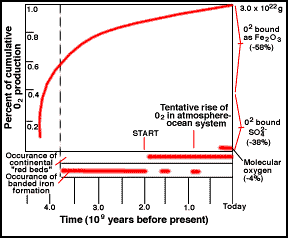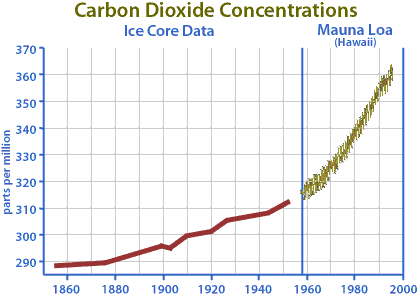Page 9 of 12: Survey of elementary geobiochemistry > the Atmosphere >
Origin and evolution of the atmosphere
Structure and composition of the atmosphere

The biosphere
Page 9 of 12: Survey of elementary geobiochemistry > the Atmosphere >Origin and evolution of the atmosphere |
|||||||||
|
Structure and composition of the atmosphere |
 |
The biosphere |
|||||||
The atmosphere of the Earth (and also of Venus and Mars) is generally believed to have its origin in relatively volatile compounds that were incorporated into the solids from which these planets accreted. Such compounds could include nitrides (a source of N2), water (which can be taken up by silica, for example), carbides, and hydrogen compounds of nitrogen and carbon. Many of these compounds (and also some noble gases) can form clathrate complexes with water and some minerals which are fairly stable at low temperatures. The high temperatures developed during the later stages of accretion as well as subsequent heating produced by decay of radioactive elements presumably released these gases the surface. Even at the present time, large amounts of CO2 , water vapor, N2, HCl, SO2 and H2S are emitted from volcanos. The more reactive of these gases would be selectively removed from the atmosphere by reaction with surface rocks or dissolution in the ocean, leaving an atmosphere enriched in its present major components with the exception of oxygen which is discussed in the next section.
Any hydrogen present would tend to escape into space, causing the atmosphere to gradually became less reducing. However there is now some doubt that hydrogen and other volatiles (mainly the inert gases) were present in the newly accreted planets in anything like their cosmic abundance. The main evidence against this is the observation that gases such as helium, neon and argon, which are among the ten most abundant elements in the universe, are depleted on the earth by factors of 10–7 to 10–11 . This implies that there was a selective removal of these volatiles prior to or during the planetary accretion process.
The overall oxidation state of the earth’s mantle is not consistent with what one would expect from equilibration with highly reduced volatiles, and there is no evidence to suggest that the composition of the mantle has not remained the same. If this is correct, then the primitive atmosphere may well have had about the same composition as the gases emitted by volcanos at the present time. These consist mainly of water and CO2, together with small amounts of N2, H2, H2S, SO2, CO, CH4, NH3, HCl and HF. If water vapor was a major component of outgassing of the accreted earth, it must have condensed quite rapidly into rain. Any significant concentration of water vapor in the atmosphere would have led to a runaway greenhouse effect, resulting in temperatures as high as 400°C.
Free oxygen is never more than a trace component of most planetary atmospheres. Thermodynamically, oxygen is much happier when combined with other elements as oxides; the pressure of O2 in equilibrium with basaltic magmas is only about 10–7 atm. Photochemical decomposition of gaseous oxides in the upper atmosphere is the major source of O2 on most planets. On Venus, for example, CO2 is broken down into CO and O2 . On the earth, the major inorganic source of O2 is the photolysis of water vapor; most of the resulting hydrogen escapes into space, allowing the O2 concentration to build up. An estimated 2 ![]() 1011 g of O2 per year is generated in this way. Integrated over the earth’s history, this amounts to less than 3% of the present oxygen abundance. The partial pressure of O2 in the prebiotic atmosphere is estimated to be no more than 10–3 atm, and may have been several orders of magnitude less. The major source of atmospheric oxygen on the earth is photosynthesis carried out by green plants and certain bacteria:
1011 g of O2 per year is generated in this way. Integrated over the earth’s history, this amounts to less than 3% of the present oxygen abundance. The partial pressure of O2 in the prebiotic atmosphere is estimated to be no more than 10–3 atm, and may have been several orders of magnitude less. The major source of atmospheric oxygen on the earth is photosynthesis carried out by green plants and certain bacteria:
H2O + CO2 ![]() {CH2O} + O2
{CH2O} + O2
A historical view of the buildup of atmospheric oxygen concentration since the beginning of the sedimentary record (3.7 ![]() 109 ybp) can be worked out by making use of the fact that the carbon in the product of the above reaction has a slightly lower C13 content than does carbon of inorganic origin. Isotopic analysis of carbon-containing sediments thus provides a measure of the amounts of photosynthetic O2 produced at various times in the past.
109 ybp) can be worked out by making use of the fact that the carbon in the product of the above reaction has a slightly lower C13 content than does carbon of inorganic origin. Isotopic analysis of carbon-containing sediments thus provides a measure of the amounts of photosynthetic O2 produced at various times in the past.
 |
||||
|
Evolution of atmospheric oxygen content Note carefully that the curve plots cumulative O2 production, but that until a few hundred million years ago, most of this was taken up by Fe(II) compounds in the crust and by reduced sulfur; only after this massive "oxygen sink" became filled did free O2 begin to accumulate in the atmosphere. [Diagram from Killeen-U Mich. site] |
||||
Carbon dioxide has probably always been present in the atmosphere in the relatively small absolute amounts now observed (around 54 ![]() 1015 mol = 54 Pmol). The reaction of CO2 with silicate-containing rocks to form precambrian limestones suggest a possible moderating influence on its atmospheric concentration throughout geological time.
1015 mol = 54 Pmol). The reaction of CO2 with silicate-containing rocks to form precambrian limestones suggest a possible moderating influence on its atmospheric concentration throughout geological time.
CaSiO3 + CO2 ![]() CaCO3 + SiO2
CaCO3 + SiO2
About ten percent of the atmospheric CO2 is taken up each year by photosynthesis. Of this, all except 0.05 percent is returned by respiration, almost entirely due to microorganisms. The remainder leaks into the slow part of the geochemical cycle, mostly as buried carbonate sediments.
Since the advent of the industrial revolution in 1860, the amount of CO2 in the atmosphere has been increasing. Isotopic analysis shows that most of this has been due to fossil-fuel combustion; in recent years, the mass of carbon released to the atmosphere by this means has been more than ten times the estimated rate of natural removal into sediments. The large-scale destruction of tropical forests, which has accelerated greatly in recent years, is believed to exacerbate this effect by removing a temporary sink for CO2.
The oceans have a large absorptive capacity for CO2 owing to its reaction with carbonate:
CO2 + CO32– ![]() 2 HCO3–
2 HCO3–
There is about 60 times as much inorganic carbon in the oceans as in the atmosphere. However, efficient transfer takes place only into the topmost (100 m) wind-mixed layer of the ocean, which contains only about one atmosphere equivalent of CO2. Further uptake is limited by the very slow transport of water into the deep ocean, which takes around 1000 years. For this reason, the buffering effect of the oceans on atmospheric CO2 is not very effective; only about ten percent of the added CO2 is taken up by the oceans.
 |
||||||
|
This set of plots, taken from an ETE page with data from NASA, shows the dramatic increase in atmospheric CO2 since the beginning of the industrial age. The "squiggles" on the Mauna Loa data reflect seasonal variations; more CO2 is taken up during the longer-daylight periods of the summer. |
||||||
|
See the FAQ page of the Carbon Dioxide Information Analysis Center for much more on this topic. |
||||||
Page last modified: 21.01.2008